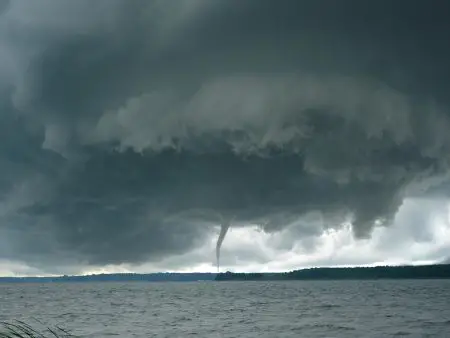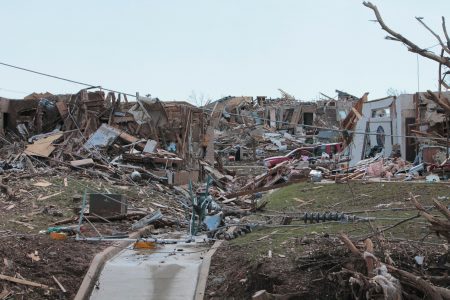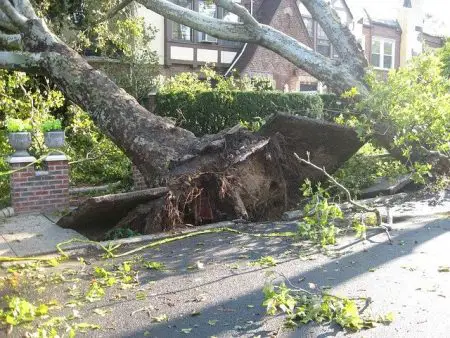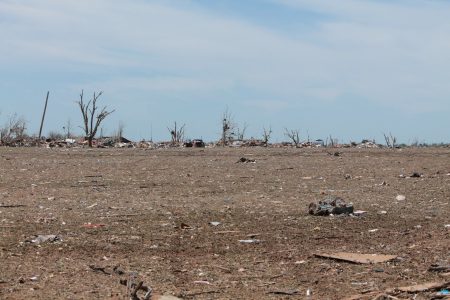Signs of a Tornado
Tornadoes often pop up with little notice with wind speeds of up 250 miles per hour and can clear a path 50 miles wide. That’s horrifying! Luckily there are usually some signs that a tornado is about to occur.
These are the 8 signs that can signal the approach of a tornado:
- Debris Falling from the Sky
- Loud Rushing Sound
- Dark Skies with a Green Hue
- Complete Calm Following a Thunderstorm
- Rotating Funnel Cloud Reaching Down from the Sky
- Approaching Cloud of Debris
- Sudden Large Heavy Hail
- Wall Clouds
Keep reading to get more information about these signs.
[wc_toggle title=“Table of Contents” padding=“” border_width=“” class=“” layout=“box”]
[/wc_toggle]
[wc_box color=“inverse” text_align=“left” margin_top=“” margin_bottom=“” class=“”]
Thanks for supporting Ready Lifestyle! We participate in the Amazon associates program and other affiliate programs. We earn a small commission on qualifying orders at no expense to you.
What Are the Signs that a Tornado is Coming?
Tornadoes are extremely powerful columns of air that extend down from the base of thunderstorms. They can happen at any time of day, at any time of the year and have been recorded in all 50 states.
They usually only last for about 10 minutes but they can last for up to an hour and travel more than 10 miles before they go away. During that time, they can tear trees from the ground, level buildings and throw objects through the air at deadly speeds.
One thing that I’ll say is to always trust your “intuition”. What I mean by this is when things get weird and you feel like something is wrong, but you don’t know why, you need to trust yourself.
Most of the time this is your brain subconsciously picking op on what’s going on before you consciously catch on. Trust yourself!
Because they can be so deadly, it’s important to know the warning signs of a tornado.

Approaching Cloud of Debris
Tornadoes throw a massive amount of material into the air. Sometimes you’ll notice that there is a lot of debris circling around for seemingly no reason.
This can happen before you can even see the swirling formation of the tornado.
Debris Falling from the Sky
Just like the swirling cloud of debris that shows up before a tornado, another way to tell that a tornado may be on the way is falling debris. Some of the material that gets sucked up into a tornado gets flung into the air and can land in the surrounding area before you can detect the tornado in other ways.
Even if it’s not a tornado, falling debris can be a sign that any number of bad things are headed your way. You should get to the best cover you have as soon as possible.
Loud Rushing Sound
The power in a tornado can sometimes cause the earth itself to rumble. This can sound like an incoming freight train where the ground rumbles loudly.
Dark Skies with a Green Hue
The clouds that often accompany tornadoes can be full of hail and ice. As more and more ice builds in the clouds, it refracts the sunlight causing a greenish color.
Don’t think that a tornado won’t form if the clouds are just really dark. It’s still possible for a tornado to form even without the green hue.
Complete Calm Following a Thunderstorm
There’s often a really strange phenomenon that comes before a tornado. A strange complete calm immediately after a thunderstorm may mean that a tornado is forming.
Sudden Large Heavy Hail
Just before a tornado, there is often large hail. This happens even if there wasn’t any rain associated with the storm.
This hail can reach sizes of up to 4 inches and can cause a lot of damage all by itself. Immediately take cover from the hail, but keep moving to a strong shelter if you can.
Rotating Funnel Cloud Reaching Down from the Sky
This is a no brainer. When you see a rotating funnel cloud reaching down from the thunderstorm toward the ground, you can be sure that a tornado is on the way.
Wall Clouds
A wall cloud is a lowering of the cloud under a thunderstorm. This can be the beginning of a tornado.
These are also called a pedestal cloud. This makes a lot more sense because they look a lot more like a pedestal than a wall.
The Difference Between a Tornado Watch and Tornado Warning
There are times when there are signs of a coming tornado and there is enough time for local and national weather services to issue a warning. When that happens, they will tell you that there is either a tornado watch or a tornado warning. They both mean that a tornado could be coming, but they mean slightly different things and require you to take slightly different actions.

Tornado Watch
A tornado watch is the lesser of the two warnings. It means that tornadoes are possible in your area. This is when you need to make sure that you’re prepared in case the watch changes to a warning.
During this time, review your emergency plans and check your supplies in your safe room. Most importantly, be ready to act if the watch is increased to a warning.
A tornado watch will usually cover multiples counties or states.
Tornado Warning
Tornado warnings mean that a tornado has been sighted or seen on radar. If you’re in a tornado warning area, you need to take action immediately!
Warnings usually cover a small county or a single city and are very specific to the local area. They’re spotted by trained weather and law enforcement officials who pass the information to local weather personnel. It means a tornado is happening right now.
What to do if a Tornado Strikes
Once you see the warning signs of a tornado, get a tornado warning or see a tornado, you need to immediately seek cover. Your life is in danger.
Go to the safest place you can reach. Get underground if you can!
Always avoid windows during a tornado.
If you have a basement you should get into the basement and cover yourself with a mattress, heavy blankets or sleeping bags to protect yourself from falling debris. If you have a heavy table or workbench get under it.
If you live in an apartment or other building without a basement you should go to the lowest floor and find an interior room to shelter in. Get low to the floor and cover your head and neck. Cover yourself with heavy blankets, sleeping bags or a mattress.
If you’re in an office building, hospital or highrise building get into an enclosed room in the middle of the building that doesn’t have any windows. Interior stairs make a good shelter and allow you to get to the ground floor quickly. Get low to the floor and cover your head and neck. Don’t use elevators!
If you live in a mobile home you should get out immediately and take shelter in a storm shelter or permanent structure. Then seek an interior room to take shelter, lay on the ground and cover your head and neck.
Schools will have a disaster response plan that the staff should follow. Go along with the plan and follow them to the place they have designated as a shelter. Get on the ground and cover your head and neck.
If you’re in a car or truck then you have two options. If traffic is light enough for you to keep driving, then move at right angles to the tornado’s path to get out of its way. If you’re too close to the tornado to drive away or there is debris or traffic preventing you from continuing to drive, you should stay in your vehicle, cover your head with your hands, a coat or blanket and duck below the level of the windows.
If you’re stuck in the open you need to realize that you’re in a very bad position, but there are still things you can do to improve your chances. Lay flat on the ground and cover your head and neck. Stay away from cars, trees, and other things that can fall or get thrown on top of you.
After the Tornado Strikes
Once the tornado has passed you should listen to emergency notification systems, NOAA Radio, and local authorities for any new information.
If you’re trapped you should cover your mouth with a cloth or a dust mask and try to contact rescuers. Send a text or call if you can. You can also try to bang on a pipe or wall or use an emergency whistle.
If you’re outside or need to travel you should avoid fallen power lines or broken utility lines. Stay out of damaged buildings until they are cleared by authorities. Stay off of your phone except for emergencies to keep the strain on cell networks to a minimum.
During clean-up, you need to make sure that you are as safe as possible. Wear sturdy footwear (preferably boots), long pants and leather gloves.
Conclusion
Tornadoes are powerful natural disasters that have the potential to strike quickly and with very little warning. That’s why it’s so important to have an idea of the signs that one may be on the way.
Always trust yourself and seek shelter as soon as possible when you see the warning signs of a tornado. If nothing happens then you’ve only lost a couple of minutes of your day. If a tornado does strike then you’ll be much better off than if you hadn’t taken shelter!
The blog post 8 Signs of a Tornado – How to Tell a Tornado is Coming and What to Do was first seen on: readylifestyle-staging.gtgrgq9c-liquidwebsites.com
8 Signs of a Tornado – How to Tell a Tornado is Coming and What to Do published first on https://readylifesytle.tumblr.com


Comments
Post a Comment